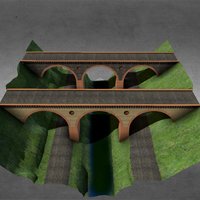Railway bridges on the river Łyna - Zabytek.pl
Also, the demonstrate scientific and historical values. The bridges were never converted after construction and their original, historical fabric is preserved. Both bridges were built using elements of historicism. They constitute an important point in the cultural landscape and urban planning of Olsztyn.
History
The bridges were built in connection with the construction of a new railway line on the Toruń–Wystruć route (currently Chernyakhovsk, Kaliningrad Oblast), which run, inter alia, through Iława, Ostróda, Olsztyn and Korsze. Subsequent section of the line were commissioned in 1871–1873. During the works in Olsztyn, a bridge route was built on the river Łyna, initially planned for two railway tracks. The first bridge (the northern one) was erected in 1871 near the current Western Railway Station, which preceded the commissioning of the connection using the bridge on the Ostróda-Olsztyn route (15.08.1873). The main railway station in Olsztyn was commissioned in 1872, which was connected with launching of the first railway connection on the section Olsztyn – Barczewo - Czerwonka (1.12.1872.). In the next years, Olsztyn became an important railway hub; subsequent connections were launched to Ostróda (1873), Morąg and Szczytno (1883), Orneta (1884), Olsztynek (1887). This resulted in growing traffic intensity and caused the need to built another bridge on Łyna, which was also planned for two railway tracks. It was analogical in terms of construction and form to the previous one and located approx. 22 m to the south from it. The works were completed in 1893. During the World War I (August 1914), the Russian army planned to blow the bridges up, which was never put into practice. The bridges also survived the World War II without any damages. After the war, Polish administration took over the railway lines on 15 August 1945. In 1989, the bridges were entered to the register of monuments. Both structures are used today in line with their intended purpose.
Description
The bridges were erected in parallel to Artyleryjska Street. Wyzwolenia Street, running below the eastern arcades of the bridges, Natalii Żarskiej Street, running below the western arcades are both divided by the river Łyna. The bridges were constructed in 1871 (the northern one) and in 1893 (the southern one), whereof the boards with dates placed in the arch over the middle span of both structures inform. The bridges are similar in structure and size; each of them is ca. 8 m wide and earmarked for two railway tracks. Both are comprised of three spans shaped as semi-circular vaults (the river flows under the middle vault). Both were built using elements of historicism (arcaded frieze, round panels with stepped edges). Northern bridge: made of stone and brick in the form of three arcades spanning 15.3 each and 20.85 h high above the water surface. The total length of the bridge is 51.88 m. The structure rests on stone foundations, arcades and pillars are of ceramic brick, section over the arcade arches are made of granite ashlars. Over the pillars, there are round panels with stepped edges, with a ceramic ventilation grid and a rainwater discharge pipe. The bridge is topped with a brick arcaded frieze. On both sides of the bridge there are granite passageways to which historical cast iron posts with panel decoration are attached, constituting an element of the balustrade. The southern bridge: made of ceramic brick — arcades of red brick, sections over arcades of yellow brick. Other structural and decorative elements are analogical to the northern bridge.
The historical structures are accessible. They may be accessed most easily from N. Żarskiej and Wyzwolenia Streets, and from the park between them.
Compiled by Adam Płoski, Area Branch of the National Heritage Board of Poland in Olsztyn, 17.10.2014.
Bibliography
- Karta ewidencyjna zabytków architektury i budownictwa, wiadukty kolejowe, oprac. J. Strużyński, B. Chlebowicz, Olsztyn 1995, archiwum Wojewódzkiego urzędu Ochrony Zabytków w Olsztynie
Category: bridge
Architecture: nieznana
Building material:
brick
Protection: Register of monuments, Monuments records
Inspire id: PL.1.9.ZIPOZ.NID_N_28_BL.37743, PL.1.9.ZIPOZ.NID_E_28_BL.30770,PL.1.9.ZIPOZ.NID_E_28_BL.31691
